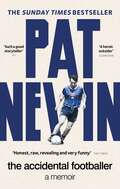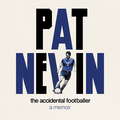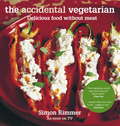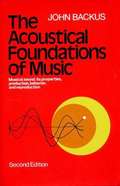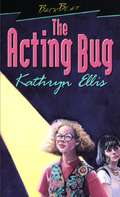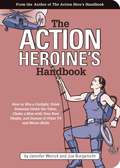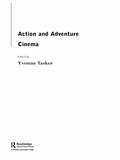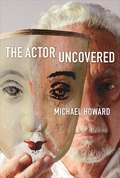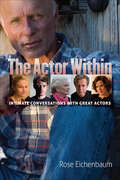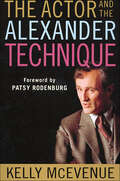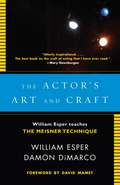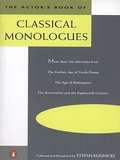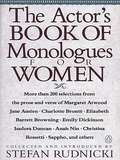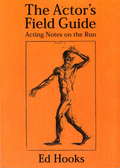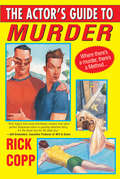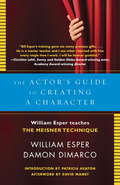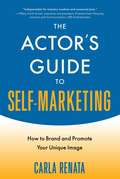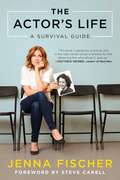- Table View
- List View
The Accidental Footballer
by Pat Nevin***THE SUNDAY TIMES BESTSELLER 'A heroic outsider - a pleasure to read.' - The Guardian'A fulsome evocation of football before the Premier League.' - The i'Such a good storyteller...joyous.' - Financial Times'Honest, raw, revealing and very funny. How to live a life and career to the full. Insightful book about the most successful outsider inside football ever...' - Henry Winter, Chief Football Writer, The Times'Pat is a wonderful one-off...and this is the story of why that is.' - John Murray, Chief Sports Correspondent, BBC Radio 5 Live'Unusually vibrant and elegant with heroic doses of humour, insight and self-effacement, this is an absolute must-read for the football connoisseur.' - Omid Djalili 'The biggest influence of my professional career both on and off the pitch.' - Graeme Le Saux'I grew up captivated by Pat Nevin the player. As a man he taught me even more about the beauty of the game. One of football's great mavericks, and Chelsea's greatest players. And he can spin a mean tune too.' - Sam Matterface 'I used to walk miles to see Pat Nevin play football and I'd do the same now to read his thoughts. Always challenging, always entertaining.' - Lord Sebastian Coe'A refreshingly honest and thought-provoking autobiography. As deftly delivered as some of Pat's ball skills in his 1980's heyday.' - ToffeeWeb Pat Nevin never wanted to be a professional footballer.His future was clear, he'd become a teacher like his brothers. There was only one problem with this - Pat was far too good to avoid attention. Raised in Glasgow's East End, Pat loved the game, playing for hours and obsessively following Celtic. But as he grew up, he also loved Joy Division, wearing his Indie 'gloom boom' coat and going on marches - hardly typical footballer behaviour!Placed firmly in the 80s and 90s, before the advent of the Premier League, and often with racism and violence present, Pat Nevin writes with honesty, insight and wry humour. We are transported vividly to Chelsea and Everton, and colourfully diverted by John Peel, Morrissey and nights out at the Hacienda.The Accidental Footballer is a different kind of football memoir. Capturing all the joys of professional football as well as its contradictions and conflicts, it's about being defined by your actions, not your job, and is the perfect reminder of how life can throw you the most extraordinary surprises, when you least expect it.
The Accidental Footballer
by Pat Nevin***THE SUNDAY TIMES BESTSELLER 'A heroic outsider - a pleasure to read.' - The Guardian'A fulsome evocation of football before the Premier League.' - The i'Such a good storyteller...joyous.' - Financial Times'Honest, raw, revealing and very funny. How to live a life and career to the full. Insightful book about the most successful outsider inside football ever...' - Henry Winter, Chief Football Writer, The Times'Pat is a wonderful one-off...and this is the story of why that is.' - John Murray, Chief Sports Correspondent, BBC Radio 5 Live'Unusually vibrant and elegant with heroic doses of humour, insight and self-effacement, this is an absolute must-read for the football connoisseur.' - Omid Djalili 'The biggest influence of my professional career both on and off the pitch.' - Graeme Le Saux'I grew up captivated by Pat Nevin the player. As a man he taught me even more about the beauty of the game. One of football's great mavericks, and Chelsea's greatest players. And he can spin a mean tune too.' - Sam Matterface 'I used to walk miles to see Pat Nevin play football and I'd do the same now to read his thoughts. Always challenging, always entertaining.' - Lord Sebastian Coe'A refreshingly honest and thought-provoking autobiography. As deftly delivered as some of Pat's ball skills in his 1980's heyday.' - ToffeeWeb Pat Nevin never wanted to be a professional footballer.His future was clear, he'd become a teacher like his brothers. There was only one problem with this - Pat was far too good to avoid attention. Raised in Glasgow's East End, Pat loved the game, playing for hours and obsessively following Celtic. But as he grew up, he also loved Joy Division, wearing his Indie 'gloom boom' coat and going on marches - hardly typical footballer behaviour!Placed firmly in the 80s and 90s, before the advent of the Premier League, and often with racism and violence present, Pat Nevin writes with honesty, insight and wry humour. We are transported vividly to Chelsea and Everton, and colourfully diverted by John Peel, Morrissey and nights out at the Hacienda.The Accidental Footballer is a different kind of football memoir. Capturing all the joys of professional football as well as its contradictions and conflicts, it's about being defined by your actions, not your job, and is the perfect reminder of how life can throw you the most extraordinary surprises, when you least expect it.
The Accidental Footballer
by Pat Nevin***THE SUNDAY TIMES BESTSELLER 'A heroic outsider - a pleasure to read.' - The Guardian'A fulsome evocation of football before the Premier League.' - The i'Honest, raw, revealing and very funny. How to live a life and career to the full. Insightful book about the most successful outsider inside football ever...' - Henry Winter, Chief Football Writer, The Times'Pat is a wonderful one-off...and this is the story of why that is.' - John Murray, Chief Sports Correspondent, BBC Radio 5 Live'Unusually vibrant and elegant with heroic doses of humour, insight and self-effacement, this is an absolute must-read for the football connoisseur.' - Omid Djalili 'The biggest influence of my professional career both on and off the pitch.' - Graeme Le Saux'I grew up captivated by Pat Nevin the player. As a man he taught me even more about the beauty of the game. One of football's great mavericks, and Chelsea's greatest players. And he can spin a mean tune too.' - Sam Matterface 'I used to walk miles to see Pat Nevin play football and I'd do the same now to read his thoughts. Always challenging, always entertaining.' - Lord Sebastian Coe'A refreshingly honest and thought-provoking autobiography. As deftly delivered as some of Pat's ball skills in his 1980's heyday.' - ToffeeWeb Pat Nevin never wanted to be a professional footballer.His future was clear, he'd become a teacher like his brothers. There was only one problem with this - Pat was far too good to avoid attention. Raised in Glasgow's East End, Pat loved the game, playing for hours and obsessively following Celtic. But as he grew up, he also loved Joy Division, wearing his Indie 'gloom boom' coat and going on marches - hardly typical footballer behaviour!Placed firmly in the 80s and 90s, before the advent of the Premier League, and often with racism and violence present, Pat Nevin writes with honesty, insight and wry humour. We are transported vividly to Chelsea and Everton, and colourfully diverted by John Peel, Morrissey and nights out at the Hacienda.The Accidental Footballer is a different kind of football memoir. Capturing all the joys of professional football as well as its contradictions and conflicts, it's about being defined by your actions, not your job, and is the perfect reminder of how life can throw you the most extraordinary surprises, when you least expect it.(p) 2021 Octopus Publishing Group
The Accidental Vegetarian: Delicious And Eclectic Food Without Meat
by Simon RimmerWhen Simon Rimmer bought a small vegetarian restaurant, he had no idea how to cook. Armed with two cookbooks and heaps of enthusiasm, he and a friend created the best vegetarian restaurant in Manchester, famous for its unusual food and lovely atmosphere. A confirmed meat eater, Simon had to rethink his cooking and has created vegetarian recipes to please even the most dedicated carnivore. This book is a collection of some of his recipes that are quick to prepare but totally delicious. From good old favourites like macaroni cheese to Simon's more exotic fusion creations such as spicy beetroot and coconut soup, The Accidental Vegetarian will kill the lentil and sandal image of vegetarianism forever!
The Accidental Vegetarian: Delicious food without meat
by Simon RimmerDeliciously simple, meat-free recipes from 'Something For The Weekend' presenter and Strictly Come Dancing contestant Simon Rimmer.
The Accompanist: An Autobiography of Andre Benoist
by Andre Benoist John Anthony MalteseBenoist moved from France to the US and became the accompanist of musicians such as Jascha Heifetz and Albert Spalding, with many tours, recordings, concerts and broadcasts over decades.
The Acoustical Foundations of Music (2nd edition)
by John BackusThe original purpose of Professor Backus's book was to collect and organize the scattered results of research, past and present, in the areas of scientific knowledge that are relevant to music: the physiological properties of sounds; the effect of acoustical environment; the acoustical behavior of musical instruments; and the various applications of electronics and computers to the production, reproduction, and composition of music. The aims and organization of the second edition remain the same; the results are more complete and up-to-date.
The Acting Bug
by Kathryn EllisTV stardom – fame, fortune, and Hollywood! It’s the chance of a lifetime for Kate Merriman when she lands a small role in a new TV series called Backbeat. But it’s less fun when Kate finds out her best friend Maria has turned down the part she’s been offered in the show. They’re always there for each other. How can Kate succeed when Maria’s not there to share this new adventure. And why doesn’t their friendship seem to work any more? In her first novel in the Backbeat series, Kathryn Ellis provides a lively look into the world of TV shows – and close friendships.
The Action Bible: Faith in Action Edition
by Sergio CarielloThis reimagining of the mega-selling Action Bible combines 230 stories of biblical heroes with vibrant comic-book-style illustrations and an immersive online experience. Readers will explore seven dynamic attributes of God&’s story, earn Faith in Action Badges representing those qualities, and discover even more through a discoverable QR code in each story that takes them to a safe online adventure of games, playlists, Bible studies, activities, and a complete devotional designed to increase their time with God. Since its release in 2010, The Action Bible has received widespread acclaim for its high-energy, engaging graphics and over 230 spiritually-transformative Bible stories. Introducing the Faith in Action program that reinvents the bestselling, comic-book-style Bible with a systematic approach to experiencing the Word of God for the next generation. In addition to an interior redesign refresh, this exciting edition includes: The Faith in Action system which gives young readers an easy-to-navigate and engaging experience for exploring the Bible through themes that connect directly to their felt needs. A Faith in Action Badge for each story that corresponds with one of seven biblical attributes: courage, faith, hope, love, service, trust, and wisdom. Discoverable QR codes in every story take readers to a safe online experience to explore even more content: videos, games, a digital Scripture index, prayers, Bible facts, devotions, playlists, reading plans, interactive maps, Bible study sessions, and more. A reading challenge chart spurs young readers on to earn a Faith in Action Title. With all the intrigue of a graphic novel and all the truth of God&’s Word, The Action Bible: Faith in Action Edition satisfies the curious minds and adventurous hearts of today&’s young learners, guiding them to connect more deeply with God&’s Word, develop a richer relationship with their Savior, and grow in their compassion for the world around them.
The Action Heroine's Handbook: How to Win a Catfight, Drink Someone Under the Table, Choke a Man with Your Bare Thighs, and Dozens of Other TV and Movie Skills
by Joe Borgenicht Jennifer WorickGet Some Action! For every woman who wants to be as tough as Lara Croft, as nimble as the Bionic Woman, and as babe-a-licious as Charlie's Angels, The Action Heroine's Handbook shows you the essential skills you'll need to conquer the bad guys and save the day without breaking a sweat. Find out how the real action heroines do it, directly from a host of experts, including stuntwomen, jujitsu instructors, helicopter pilots, detectives, forensic psychologists, survivalists, primatologists, and many others. Learn to: * Profile a serial killer * Outwit a band of home intruders * Navigate white water rapids * Go undercover as a beauty queen * Outrun a fireball, and dozens of other Tough Chick Skills, Beauty Skills, Brain Skills, Brawn Skills, and Escape Skills. Special sections and appendices feature the top action heroine hairdos, handbag essentials, and the best footwear for every action situation. With step-by-step instructions and easy-to-follow illustrations, The Action Heroine's Handbook will prepare you to save the world, one baddie at a time.
The Action and Adventure Cinema
by Yvonne TaskerThis exciting collection addresses action and adventure from the silent to the contemporary period exploring diverse questions of aesthetics, industry and ideology. Action has established itself as one of the leading commercial genres of the New Hollywood cinema, generating extensive debate in the process.Contributors consider how action might best be defined, how it has developed historically, and how it works formally. The critical reception and standing of action and adventure cinema is considered in relation to questions of national culture, violence and the 'art' of cinema.Themes explored include genre and definitions; early action, sensation and melodrama; authorship and action; national and transnational action-adventure traditions; action aesthetics; spectacle and narrative; stars and bodies; class; gender; race and ethnicity. Attempting to evaluate the significance of this type of filmmaking for both popular cinema and film studies, the book underlines the central place of action and adventure within film history.
The Actor And The Text
by Cicely BerryCicely Berry, Voice Director of the Royal Shakespeare Company, is world-famous for her voice teaching. The Actor and the Text is her classic book, distilled from years of working with actors of the highest calibre.
The Actor Speaks: Voice and the Performer
by Patsy RodenburgIn The Actor Speaks, Patsy Rodenburg takes actors and actresses, both professional and beginners, through a complete voice workshop. She touches on every aspect of performance work that involves the voice and sorts through the kinds of vexing problems every performer faces onstage: breath and relaxation; vocal range and power; communication with other actors; singing and acting simultaneously; working on different sized stages and in both large and small auditoriums; approaching the vocal demands of different kinds of scripts. This is the final word on the actor's voice and it's destined to become the classic work on the subject for some time to come.
The Actor Uncovered
by Michael HowardA Far-Reaching and Truthful Exploration of Acting in All Its FormsThe Actor Uncovered is certainly not a set of rigid rules advocating one "method" or one singular "truth." Departing from the common guidebook format, Michael Howard uses a unique approach to teaching acting, reflecting on his own history and sharing his own experiences as an actor, director, and teacher. How he writes about the process and craft of acting is at once intensely personal and relatable by others.Readers are invited to participate as though present in this master teacher's classes. Each human being, and thus each actor, is unique. Howard encourages actors to uncover their own ways of working, using their particular abilities and personality traits. Going beyond the craft and into human psychology and the importance of acting as a life force, readers will see new and deeper ways to study and practice, to be introspective, and to arrive at places of revelation about their craft.The Actor Uncovered will have much to say to beginners, to those who are advanced, and to professional and working actors. Howard discusses such topics as:Techniques, styles, and methods in a changing societyRelaxation, concentration, and the breathThe relationships among actor, director, and writerMemoryOn camera versus on stageObstaclesAfter more than seventy years as a professional actor, director, and teacher, Howard shows how living creatively and invoking one's own personality can lead to a successful career as an actor.
The Actor Within: Intimate Conversations with Great Actors
by Rose EichenbaumIn Rose Eichenbaum's third work on the confluence of art making and human expression, she delves into the lives of thirty-five celebrated actors through intimate conversations and photographic portraits. With her probing questions and disarming manner, she captures the essential character of her subjects while shining a light on the art that defines them. The work provides extraordinary insights on the craft of acting with discussions of process, techniques, tools of the trade, and how to advice for aspiring actors from seasoned veterans. These stars of stage and screen, known for signature roles and critically acclaimed performances, emerge in The Actor Within with masks and wardrobe removed. Here, they speak their own lines, tell their own stories, and raise the curtain on what it means to live the actor's life—the challenge of mastering their craft, the drama of big breaks and career woes, the search for meaningful roles, and above all, having the courage to bare their souls before theater audiences or the camera. For the artists featured in this work, acting is more than a profession; it is how they make their way in the world and artfully merge their inner sense of humanness with universal truths. This collection serves as an important inspirational resource for anyone interested in making art, regardless of medium.The Actor Within includes interviews with Karl Malden, Ruby Dee, Ed Harris, Piper Laurie, Marcia Gay Harden, William H. Macy, Ellen Burstyn, Joe Mantegna, Debra Winger, Julia Stiles, Elliott Gould, Elijah Wood, Stockard Channing, Bill Pullman, Amanda Plummer, Marlee Matlin, Charles Durning, Marsha Mason, and many others.
The Actor and the Alexander Technique
by Kelly McEvenueF.M. Alexander developed the Alexander Technique of movement in the early 20th century. Combining vocal clarity and body movement, Alexander developed a performance coaching method that is used by dancers, actors, singers, etc. In The Actor and the Alexander Technique, Kelly McEvenue writes the first basic book about how this unique technique can help actors feel more natural on the stage. She provides warm-up exercises, "balance" and "center" exercises, spatial awareness exercises. She talks about imitation, the use of masks, nudity on the stage, dealing with injury and aging. She talks about specific productions that have successfully used the Alexander Technique, such as "The Lion King". With a foreword by Patsy Rodenburg of our own phenomenal The Actor Speaks this is a book that belongs on the shelf of every working and studying actor.
The Actor and the Text
by Cicely BerryThe Actor and His Text is a direct extension of Cicely Berry's first book, Voice and the Actor. It sets out to apply the methods of voice production directly and practically to the speaking of text. Specifically, it addresses the problem of how to infuse life and meaning into words that are first encountered on the printed page. While the greater part of her book is about the speaking of Shakespeare, Cicely Berry also includes the speaking of modern plays, such as those of Davis Rudkin and Edward Bond. She expands, too, on the exercises given in Voice and the Actor which help to develop relaxation, breathing and muscular control.
The Actor's Art and Craft: William Esper Teaches the Meisner Technique
by William Esper Damon DimarcoWilliam Esper, one of the leading acting teachers of our time, explains and extends Sanford Meisner's legendary technique, offering a clear, concrete, step-by-step approach to becoming a truly creative actor.Esper worked closely with Meisner for seventeen years and has spent decades developing his famous program for actor's training. The result is a rigorous system of exercises that builds a solid foundation of acting skills from the ground up, and that is flexible enough to be applied to any challenge an actor faces, from soap operas to Shakespeare. Co-writer Damon DiMarco, a former student of Esper's, spent over a year observing his mentor teaching first-year acting students. In this book he recreates that experience for us, allowing us to see how the progression of exercises works in practice. The Actor's Art and Craft vividly demonstrates that good training does not constrain actors' instincts—it frees them to create characters with truthful and compelling inner lives.
The Actor's Book of Classical Monologues
by VariousA challenging, wide-ranging collection of monologues from history’s greatest dramatic works. From the stately and poetic Greek tragedies to the lively, bawdy Restoration comedies, the classical repertoire is a treasure trove of often-overlooked materials for male and female, young and old. The solo pieces collected here vary widely in mood, style, and level of challenge; they include a generous supply of Shakespeare and his contemporaries; and they’re fleshed out with brief plot synopses and valuable historical material. Stefan Rudnicki, an accomplished actor, director, and teacher, also provides practical tips on preparing each scene for audition or performance. Among the playwrights whose works are included are: Aeschylus Sophocles Euridipes Aristophanes Shakespeare Tourneur Kyd Middleton Jonson Sheridan Dryden Congreve …and many others.
The Actor's Book of Monologues for Women
by VariousA diverse collection of monologues featuring the voices of women through the ages Drawn from poetry, fiction, diaries, journals, and documents of public record, these selections, although not originally intended for theatrical or cinematic performances, offer unique dramatic opportunities for actors, speakers, students, or anyone interested in women’s studies. Stefan Rudnicki has brought together selections from well-known as well as obscure authors, providing a tremendous range of women’s perspectives from a variety of sources: poems by Elizabeth Barrett Browning, Emily Dickinson, Christina Rossetti, and Sappho, among others; passages from Mary Shelley’s journal, the diaries of Anais Nin, and the memoirs of Isadora Duncan; polemics from Mary Wollstonecraft and Joan of Arc, as well as Susan B. Anthony’s “On Woman’s Right to Suffrage”; and selections from the novels of Emily and Charlotte Bronte, Jane Austen, Ursula K. LeGuin, and others.
The Actor's Field Guide
by Ed HooksFrom a veteran actor, teacher, and author, here is a quick-reference guide aimed at working actors. Got a funny scene that doesn't seem very funny? Look up "comedy." Got a scene in which you're supposed to cry? Look up "cry." Each entry includes a brief introduction to the topic, followed by several pages of short, bulleted tips or "field notes" that offer quick solutions to any acting problem. In addition, there are brief essays throughout that expand on some of the trickier aspects of the actor's craft. Edgy, concise, and infinitely helpful, no working actor will want to be without this one-of-a-kind guide.* There are 100,000 members in actors unions in the US, with a 50% turnover* Unique quick reference guide for busy actors* Advice on everything from rehersals to auditioning and memorizing lines* Author has trained thousands of actors, including Heather Locklear and Teri Hatcher* Advertising in Back Stage magazineFrom the Trade Paperback edition.
The Actor's Guide To Murder
by Rick Copp"Baby, don't even go there!" That was Jarrod Jarvis's catch phrase as the adorable, girl-crazy moppet on the eighties sitcom, Go To Your Room! It was a great ride until the tabloids caught the popular teen idol kissing another guy at the L. A. gay rodeo. "Gay" and "teen heartthrob" not exactly being career-making words at the time, Jarrod's star crashed harder than a Kathie Lee Gifford CD. Flash forward: Now happily living with his cop boyfriend, Charlie, and their dog, Snickers, in the Hollywood Hills, Jarrod's ready to hit the comeback trail. . . but he never imagines how fame will strike this time. At a reading with his psychic, Jarrod is disturbed to hear that someone close to him will be murdered and even more shocked when it turns out to be his best friend, Willard Ray Hornsby, also a former child star. When Willard is found face down in his own lap pool, the cops call it an accident, but Jarrod's far from convinced--and he's ready to play the Sherlock Holmes of West Hollywood to prove his conspiracy theory right. . . "Fast-paced and very funny, with a hip insider's view of Hollywood. The Actor's Guide to Murder is the reader's guide to a terrific time. I loved it. " --Laura Levine, author of Last Writes "A pumped-up, promising debut. . . the story has considerable zest and enough sprightly humor to keep readers glued and giggling. " --Publishers Weekly "I laughed all the way through The Actor's Guide to Murder. Here's hoping Jarrod stumbles across another dead body, and soon!" --Dean James, author of Decorated to Death "Rick Copp's Actor's Guide mysteries read like some hilariously wicked Lifestyles of the Rich and Infamous--revealing juicy Hollywood secrets by the page!" --Jerrilyn Farmer, author of Mumbo Gumbo
The Actor's Guide to Creating a Character: William Esper Teaches the Meisner Technique
by David Mamet Patricia Heaton William Esper Damon DimarcoWilliam Esper, one of the most celebrated acting teachers of our time, takes us through his step-by-step approach to the central challenge of advanced acting work: creating and playing a character. Esper's first book, The Actor's Art and Craft, earned praise for describing the basics taught in his famous first-year acting class. The Actor's Guide to Creating a Character continues the journey. In these pages, co-author Damon DiMarco vividly re-creates Esper's second-year course, again through the experiences of a fictional class. Esper's training builds on Sanford Meisner's legendary exercises, a world-renowned technique that Esper further developed through his long association with Meisner and the decades he has spent training a host of distinguished actors. His approach is flexible enough to apply to any role, helping actors to create characters with truthful and compelling inner lives.
The Actor's Guide to Self-Marketing: How to Brand and Promote Your Unique Image
by Carla RenataStand Out from the Competition! How do actors sell their personality? What does it take to make a lasting impression? How can actors use their image to achieve their dreams? The Actor's Guide to Self-Marketing answers all these questions and more. With a background in acting and publicity, author Carla Renata has gathered insider info and proven tips to help actors create their own brand and utilize it for success. With The Actor's Guide to Self-Marketing, you will learn how to: Highlight unique traits and skills Distinguish yourself from the crowd Market yourself through social media Angle for your dream role And so much more! Renata's methods have been tested and developed through her branding and social media program, The Branding Buddha, which has been taught online and privately, as well as in group classes at top universities in the United States. Along with tips from her program and extensive background in the field, Renata uses meditative practices and self-actualization to help actors develop their public image and reach their goals with clarity and intention. As she writes, "The mind is everything. What you think, you will become." With The Actor's Guide to Self-Marketing, you'll be well on your way to becoming the actor you really want to be and landing your dream roles.
The Actor's Life: A Survival Guide
by Jenna FischerJenna Fischer's Hollywood journey began at the age of 22 when she moved to Los Angeles from her hometown of St. Louis. With a theater degree in hand, she was determined, she was confident, she was ready to work hard. So, what could go wrong? Uh, basically everything. The path to being a professional actor was so much more vast and competitive than she'd imagined. It would be eight long years before she landed her iconic role on The Office, nearly a decade of frustration, struggle, rejection and doubt. If only she'd had a handbook for the aspiring actor. Or, better yet, someone to show her the way—an established actor who could educate her about the business, manage her expectations, and reassure her in those moments of despair. Jenna wants to be that person for you. With amusing candor and wit, Fischer spells out the nuts and bolts of getting established in the profession, based on her own memorable and hilarious experiences. She tells you how to get the right headshot, what to look for in representation, and the importance of joining forces with other like-minded artists and creating your own work—invaluable advice personally acquired from her many years of struggle. She provides helpful hints on how to be gutsy and take risks, the tricks to good auditioning and callbacks, and how not to fall for certain scams (auditions in a guy's apartment are probably not legit—or at least not for the kind of part you're looking for!). Her inspiring, helpful guidance feels like a trusted friend who's made the journey, and has now returned to walk beside you, pointing out the pitfalls as you blaze your own path towards the life of a professional actor.
